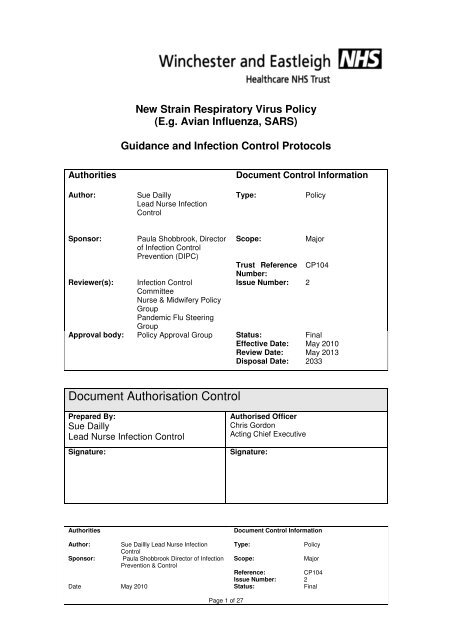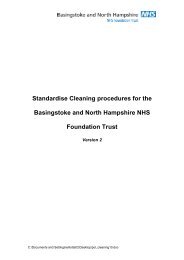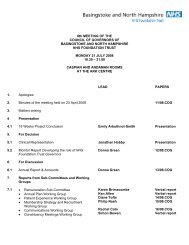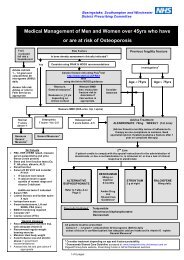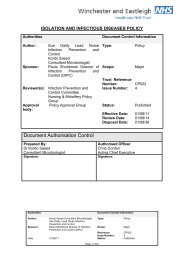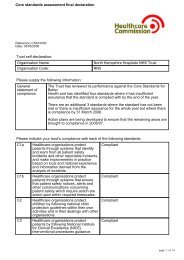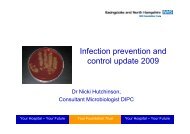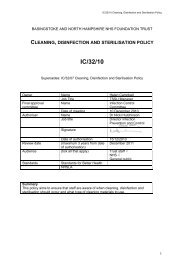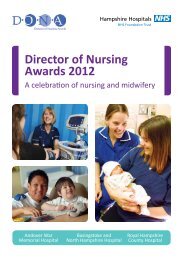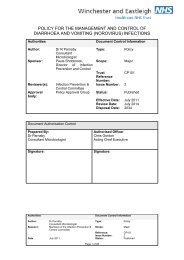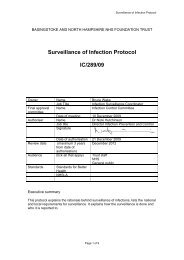New Strain Respiratory Virus Policy - Hampshire Hospitals NHS ...
New Strain Respiratory Virus Policy - Hampshire Hospitals NHS ...
New Strain Respiratory Virus Policy - Hampshire Hospitals NHS ...
Create successful ePaper yourself
Turn your PDF publications into a flip-book with our unique Google optimized e-Paper software.
<strong>New</strong> <strong>Strain</strong> <strong>Respiratory</strong> <strong>Virus</strong> <strong>Policy</strong><br />
(E.g. Avian Influenza, SARS)<br />
Guidance and Infection Control Protocols<br />
Authorities<br />
Document Control Information<br />
Author:<br />
Sue Dailly<br />
Lead Nurse Infection<br />
Control<br />
Type:<br />
<strong>Policy</strong><br />
Sponsor:<br />
Reviewer(s):<br />
Paula Shobbrook, Director<br />
of Infection Control<br />
Prevention (DIPC)<br />
Infection Control<br />
Committee<br />
Nurse & Midwifery <strong>Policy</strong><br />
Group<br />
Pandemic Flu Steering<br />
Group<br />
Scope:<br />
Major<br />
Trust Reference CP104<br />
Number:<br />
Issue Number: 2<br />
Approval body: <strong>Policy</strong> Approval Group Status: Final<br />
Effective Date: May 2010<br />
Review Date: May 2013<br />
Disposal Date: 2033<br />
Document Authorisation Control<br />
Prepared By:<br />
Sue Dailly<br />
Lead Nurse Infection Control<br />
Signature:<br />
Authorised Officer<br />
Chris Gordon<br />
Acting Chief Executive<br />
Signature:<br />
Authorities<br />
Document Control Information<br />
Author: Sue Daillly Lead Nurse Infection Type:<br />
<strong>Policy</strong><br />
Control<br />
Sponsor: Paula Shobbrook Director of Infection Scope:<br />
Major<br />
Prevention & Control<br />
Reference:<br />
CP104<br />
Issue Number: 2<br />
Date May 2010 Status: Final<br />
Page 1 of 27
Winchester & Eastleigh Healthcare <strong>NHS</strong> Trust<br />
<strong>New</strong> <strong>Strain</strong> <strong>Respiratory</strong> <strong>Virus</strong> <strong>Policy</strong><br />
DOCUMENT CONTROL<br />
Document Amendments<br />
Number Details By Whom Date<br />
1 Reviewed as a new strain of S.Dailly<br />
December<br />
influenza has occurred and Lead Nurse Infection 2009<br />
caused a pandemic<br />
Control<br />
Review Timetable<br />
Date Reason By Whom Date<br />
Completed<br />
Dec 2009 Reviewed as a new strain of<br />
influenza has occurred and<br />
caused a pandemic<br />
S.Dailly<br />
Lead Nurse Infection<br />
Control<br />
Feb 2013 Three year review Infection Control team<br />
Distribution List<br />
No Title<br />
1 Core <strong>Policy</strong> Holders<br />
2 Intranet<br />
3 Winchester & Eastleigh Healthcare <strong>NHS</strong> Trust Website<br />
RELATED TRUST POLICIES<br />
CP074 Infection control assurance framework and roles and responsibilities<br />
CP076 Standard precautions and PPE policy<br />
Authorities<br />
Document Control Information<br />
Author: Sue Daiilly Lead Nurse Infection Type:<br />
<strong>Policy</strong><br />
Control<br />
Sponsor: Paula Shobbrook Director of Infection Scope:<br />
Major<br />
Prevention and Control<br />
Reference:<br />
CP104<br />
Issue Number: 2<br />
Date May 2010 Status: Final<br />
Page 2 of 27
Winchester & Eastleigh Healthcare <strong>NHS</strong> Trust<br />
<strong>New</strong> <strong>Strain</strong> <strong>Respiratory</strong> <strong>Virus</strong> <strong>Policy</strong><br />
CP072 Training policy for employees of WECHT in infection control<br />
CP062 Pandemic Influenza Plan<br />
CP077 <strong>Policy</strong> for ward closure<br />
CP061 <strong>Policy</strong> for the Intraward Transfer of Patients with Infection Control<br />
Issues<br />
CP070 Deceased Infected Patient <strong>Policy</strong><br />
CP073 Hand hygiene policy<br />
CP061 <strong>Policy</strong> for the inter and intra ward transfer of patients with infection<br />
control issues.<br />
Authorities<br />
Document Control Information<br />
Author: Sue Daiilly Lead Nurse Infection Type:<br />
<strong>Policy</strong><br />
Control<br />
Sponsor: Paula Shobbrook Director of Infection Scope:<br />
Major<br />
Prevention and Control<br />
Reference:<br />
CP104<br />
Issue Number: 2<br />
Date May 2010 Status: Final<br />
Page 3 of 27
Winchester & Eastleigh Healthcare <strong>NHS</strong> Trust<br />
<strong>New</strong> <strong>Strain</strong> <strong>Respiratory</strong> <strong>Virus</strong> <strong>Policy</strong><br />
Contents<br />
Section Title Page<br />
1.0 Purpose 5<br />
2.0 Scope 5<br />
3.0 Duties and responsibilities 5<br />
4.0 Introduction 6<br />
5.0 Pandemic strain 8<br />
6.0 Symptoms 8<br />
7.0 Illness in travellers returning to UK 8<br />
8.0 Travel to affected countries 9<br />
9.0 <strong>New</strong> vaccines 9<br />
10.0 The beginning of a pandemic 9<br />
11.0 Who to contact for advice 11<br />
12.0 Case definition 11<br />
13.0 Investigations 12<br />
14.0 Microbial testing 13<br />
15.0 Isolation and infection control precautions 14<br />
16.0 Laboratory samples 17<br />
17.0 Patient transfers 18<br />
18.0 Decontamination of equipment and room 18<br />
19.0 Family contacts 18<br />
20.0 General considerations 19<br />
21.0 Larger number of cases 19<br />
22.0 Training 20<br />
23.0 For More Information 21<br />
Appendix 1 Infection Control Action card 22<br />
Appendix 2 Putting on and removing PPE 23<br />
Appendix 3 Contacts 25<br />
Appendix 4 Equality impact assessment 26<br />
Authorities<br />
Document Control Information<br />
Author: Sue Daiilly Lead Nurse Infection Type:<br />
<strong>Policy</strong><br />
Control<br />
Sponsor: Paula Shobbrook Director of Infection Scope:<br />
Major<br />
Prevention and Control<br />
Reference:<br />
CP104<br />
Issue Number: 2<br />
Date May 2010 Status: Final<br />
Page 4 of 27
Winchester & Eastleigh Healthcare <strong>NHS</strong> Trust<br />
<strong>New</strong> <strong>Strain</strong> Influenza <strong>Policy</strong><br />
1 PURPOSE<br />
This plan deals with the first one or few cases of a new strain of respiratory<br />
virus e.g. Rhinoviruses, respiratory syncytial virus, influenza viruses A, B and C,<br />
para-influenza viruses and coronaviruses including SARS or emerging strain,<br />
which may present to this Trust via primary care or Accident and<br />
Emergency(A&E). Planning is based on maximal efforts to contain spread of a<br />
new strain to other susceptible patients, staff and visitors whilst providing<br />
optimal care for the affected individuals.<br />
Please note instructions will be reviewed when more information regarding the<br />
new strain become available.<br />
2 SCOPE<br />
This policy extends to cover all Winchester and Eastleigh Healthcare <strong>NHS</strong><br />
Trust employees. This policy will also apply to honorary contract holders and<br />
staff employed by other organizations, who work with the Winchester and<br />
Eastleigh Healthcare <strong>NHS</strong> Trust patients and for the Trust’s other staff.<br />
This policy complements professional and ethical guidelines and the Nursing<br />
and Midwifery Council Code of Professional Conduct (NMC 2008).<br />
The policy is ratified in line with the CPO01<strong>Policy</strong> for the Management of<br />
Controlled Documents.<br />
3 DUTIES AND RESPONSIBILITIES<br />
Chief Executive (CEO)<br />
The CEO has overall responsibility for ensuring the Trust has appropriate<br />
strategies, policies and procedures in place to ensure the Trust continues to<br />
work to best practice and complies with all relevant legislation. The CEO has<br />
responsibility to ensure there is a safe environment for staff and patients<br />
Trust Board<br />
The Board is responsible for ensuring the strategic context of this policy is<br />
appropriate and meets the needs of the Trust.<br />
Infection Control Team<br />
The Infection Control Team is responsible for updating this policy and<br />
ensuring it represents best practice and is based on current evidenced based<br />
information.<br />
Line managers<br />
Line mangers are responsible for ensuring adequate dissemination and<br />
implementation of this policy. They are responsible for identifying any training<br />
Authorities<br />
Document Control Information<br />
Author: Sue Dailly Lead Nurse Infection Type:<br />
<strong>Policy</strong><br />
Control<br />
Sponsor: Director of Infection Prevention and Scope:<br />
Major<br />
Control<br />
Reference:<br />
CP0<br />
Issue Number: 2<br />
Date January 2010 Status: draft<br />
Page 5 of 27
Winchester & Eastleigh Healthcare <strong>NHS</strong> Trust<br />
<strong>New</strong> <strong>Strain</strong> <strong>Respiratory</strong> <strong>Virus</strong> <strong>Policy</strong><br />
needs on the implementation of new or updated policies. They are<br />
responsible for ensuring adequate facilities and resources are available to<br />
adhere to this policy and that any changes in practice are implemented. Line<br />
managers are responsible for ensuring that all Infection Control (IC) policies<br />
and procedures are accessible for all their staff and that their staff have read<br />
them.<br />
All Trust employees<br />
All staff are responsible for ensuring their compliance to this policy to ensure<br />
the safety of all patients, staff, visitors and contracted staff to this Trust.<br />
Information regarding the failure to comply with this policy e.g. lack of training<br />
or inadequate equipment must be reported to the line manager and the<br />
incident reporting system used where appropriate. If patient or staff safety is<br />
compromised as a result of the revised policy, staff must inform their line<br />
manager and ensure that a risk assessment is completed and reported<br />
through divisional risk forums and the Trust Patient Safety Manager.<br />
It is the responsibility of individual practitioners to ensure they receive the<br />
education they require to improve their knowledge, skills and competence as<br />
stated in CP072 Training policy for employees of WECHT in infection control.<br />
They are accountable to themselves, their line manager and the patient in<br />
acknowledging their limitations and to verbalize their concerns in caring for<br />
patients who have a new strain of respiratory virus such as influenza.<br />
4 INTRODUCTION<br />
Viral diseases pose a continual threat to human populations. As we live in<br />
ever-increasing populations and become increasingly mobile so it is inevitable<br />
that new viruses, such as SARS-CoV or new hyper-virulent influenza stain will<br />
appear.<br />
<strong>Respiratory</strong> infections are common including rhinoviruses, respiratory<br />
syncytial virus, influenza viruses A, B and C, para-influenza viruses and<br />
coronaviruses including SARS. Most infections with these viruses are fairly<br />
mild, self-limiting and confined to the upper respiratory tract. However, these<br />
viruses can undergo genetic changes and mutations and can emerge or reemerge<br />
as more virulent agents and cause more severe infections and even<br />
death. A new type or sub type of respiratory viruses may arise at any time,<br />
the main processes in the evolution of emerging new viruses are not fully<br />
clear, particularly the selection pressures faced by viruses in new host<br />
species. Although the high mutation rates of RNA viruses like Influenza and<br />
SARS provide them with great adaptability and explain why they are the main<br />
cause of emerging diseases, their limited genome size means that they are<br />
also subject to major evolutionary constraints. Viral genetic factors have also<br />
Authorities<br />
Document Control Information<br />
Author: Sue Daiilly Lead Nurse Infection Type:<br />
<strong>Policy</strong><br />
Control<br />
Sponsor: Paula Shobbrook Director of Infection Scope:<br />
Major<br />
Prevention and Control<br />
Reference:<br />
CP104<br />
Issue Number: 2<br />
Date May 2010 Status: Final<br />
Page 6 of 27
Winchester & Eastleigh Healthcare <strong>NHS</strong> Trust<br />
<strong>New</strong> <strong>Strain</strong> <strong>Respiratory</strong> <strong>Virus</strong> <strong>Policy</strong><br />
been implicated in the emergence of SARS-CoV, with the suggestion that this<br />
virus is a recombinant between mammalian and avian coronaviruses.<br />
Outbreaks of respiratory virus infection derive their importance from the<br />
rapidity with which epidemics evolve and the widespread morbidity and the<br />
seriousness of complications, notably increased hospitalizations and mortality<br />
due to viral and bacterial pneumonias. Patients with compromised immune,<br />
cardiac, or pulmonary systems, pregnant ladies and patients at extremes of<br />
age are at increased risk of serious complications of infection. There is a<br />
seasonal problem of epidemic respiratory virus infections in the UK<br />
<strong>Respiratory</strong> Syncitial virus (RVS) causes annual winter epidemics usually<br />
occurring in children from November to January. Influenza also occurs during<br />
winter months and can affect all age groups, particularly the elderly and the<br />
immunocompromised. <strong>New</strong>ly emerging diseases such as SARS and Avian<br />
Influenza or even a new respiratory virus have the potential to cause severe<br />
human illness. Generally these infections can be acquired by direct and<br />
indirect contact. Transmission occurs from person to person by close contact,<br />
predominantly by large droplet/airborne respiratory secretions and/or<br />
contamination of hands. Infected healthcare workers and visitors are potential<br />
sources of hospital acquired infection.<br />
In general the clinical picture of these infections is generally similar to flu e.g.<br />
fever, headache, myalgia (muscle pain), prostration (collapse), rhinorrhoea<br />
(runny nose), sore throat and cough. They derive their importance from the<br />
rapidity with which epidemics evolve and the widespread morbidity and the<br />
seriousness of complications, notably viral and bacterial pneumonias. During<br />
major epidemics, severe disease and deaths occur primarily among not only<br />
the elderly and those debilitated by chronic disease: pulmonary, cardiac, renal<br />
or metabolic disease, anaemia or immunosuppression, but also in previously<br />
fit and healthy individuals.<br />
To aid healthcare planning, surveillance of infections is used to alert healthcare<br />
providers to diagnostic considerations, management and prevention<br />
options. Every <strong>NHS</strong> body under The Health Act (2006) must ensure ‘ so far as<br />
is reasonably practicable, patients staff and other persons are protected<br />
against risks of acquiring HCAIs...’ The principles of managing a new strain in<br />
this country are the same where ever it originates from, and however it arrives<br />
here. This guidance for new strain influenza can be adapted to manage any<br />
new influenza or viral respiratory infection e.g. SARS, Avian or Swine flu. If<br />
many cases occur, a pandemic will be declared and the CP062 Pandemic<br />
Influenza Plan available on the intranet should be followed.<br />
Authorities<br />
Document Control Information<br />
Author: Sue Daiilly Lead Nurse Infection Type:<br />
<strong>Policy</strong><br />
Control<br />
Sponsor: Paula Shobbrook Director of Infection Scope:<br />
Major<br />
Prevention and Control<br />
Reference:<br />
CP104<br />
Issue Number: 2<br />
Date May 2010 Status: Final<br />
Page 7 of 27
Winchester & Eastleigh Healthcare <strong>NHS</strong> Trust<br />
<strong>New</strong> <strong>Strain</strong> <strong>Respiratory</strong> <strong>Virus</strong> <strong>Policy</strong><br />
5 THE NEW PANDEMIC STRAIN<br />
SARS, Avian or swine and human influenza viruses can exchange genes<br />
especially when similar viruses simultaneously infect the same host. This can<br />
give rise to a completely new subtype of the virus to which few, if any,<br />
humans would have natural immunity. This could give rise to a global<br />
epidemic or (a pandemic) in humans.<br />
Existing vaccines may not be effective against a completely new influenza<br />
virus.<br />
A pandemic may be prevented by reducing human exposure to infected hosts<br />
by rapid detection of outbreaks followed by appropriate infection control and<br />
public health measures.<br />
6 SYMPTOMS<br />
Incubation period and symptoms varies depending on the strain, but in<br />
general the median incubation period is around 3 days (range 2-7 days). Early<br />
symptoms in humans are fever, cough, sore throat, rhinorrhoea, myalgia,<br />
conjunctivitis, watery diarrhea, vomiting and severe unexplained respiratory<br />
illness. The severity of illness varies from mild symptoms to severe respiratory<br />
infection and death.<br />
Infectivity period again would depend on the infectious agent it is not<br />
unreasonable to assume that people are infectious while symptomatic for a<br />
period five days from the onset of symptoms. Immunosuppressed individuals<br />
are usually infectious for a prolong period of time.<br />
7 ILLNESS IN TRAVELERS RETURNING TO THE UK FROM<br />
AFFECTED COUNTRIES<br />
When a new respiratory strain is identified outside the UK, travel restrictions<br />
will be announced and placed on the web sites of the Department of Health<br />
(www.dh.gov.uk) and Health Protection Agency (www.hpa.org.uk).<br />
The Infection Control Team will advise the Flu Planning Group and the IM&T<br />
department to ensure there is a link set up to an up to date list of affected<br />
areas on the Flu Pandemic intranet site during this time.<br />
The key to the risk assessment is whether the returning traveler has visited a<br />
country on the list of countries affected by the new strain within the past seven<br />
days and had close contact with other infected hosts or whatever the ‘source’<br />
has been identified as.<br />
Authorities<br />
Document Control Information<br />
Author: Sue Daiilly Lead Nurse Infection Type:<br />
<strong>Policy</strong><br />
Control<br />
Sponsor: Paula Shobbrook Director of Infection Scope:<br />
Major<br />
Prevention and Control<br />
Reference:<br />
CP104<br />
Issue Number: 2<br />
Date May 2010 Status: Final<br />
Page 8 of 27
Winchester & Eastleigh Healthcare <strong>NHS</strong> Trust<br />
<strong>New</strong> <strong>Strain</strong> <strong>Respiratory</strong> <strong>Virus</strong> <strong>Policy</strong><br />
The case should be discussed with a Consultant Microbiologist or<br />
Communicable Disease specialist.<br />
8 TRAVEL TO AFFECTED COUNTRIES<br />
Latest travel advice is posted on the Department of Health website<br />
(www.dh.gov.uk). When a new strain is identified the Infection Control Team<br />
will keep advice on the link to an up to date list of affected countries on the<br />
intranet.<br />
9 VACCINES AGAINST NEW STRAINS<br />
The WHO recommends which prototype vaccine to be used in the event of a<br />
pandemic. Manufacturers will be advised to produce a vaccine based on their<br />
advice.<br />
9.1 Priority groups for vaccine<br />
The Department of Health will make the decision based on advice from the<br />
Joint Committee on Vaccination and Immunisation (JCVI). The JCVI has<br />
provisionally advised the following order for vaccinating people:<br />
• Healthcare workers most at risk<br />
• Clinical ‘high-risk’ groups – e.g. chronic illness, pregnant women,<br />
children under 5 years of age<br />
• Closed communities such as nursing homes<br />
• Essential service workers<br />
• General population.<br />
9.2 Anti-viral drugs for prevention (prophylaxis) and treatment<br />
The use of antivirlas e.g. (amantadine and rimantadine) and the<br />
neuraminidase inhibitors (oseltamivir (Tamiflu) and zanimivir (Relenza)<br />
against influenza or ribavirin against RSV must be revised and discussed with<br />
a microbiologist or communicable diseases specialist particularly in the early<br />
stages of a pandemic.<br />
10 THE BEGINNING OF A PANDEMIC<br />
The World Health Organization will announce the start of a pandemic and will<br />
inform governments. These viruses can be highly infectious, and they are<br />
likely to spread despite efforts to contain them. Travelers may bring viruses<br />
Authorities<br />
Document Control Information<br />
Author: Sue Daiilly Lead Nurse Infection Type:<br />
<strong>Policy</strong><br />
Control<br />
Sponsor: Paula Shobbrook Director of Infection Scope:<br />
Major<br />
Prevention and Control<br />
Reference:<br />
CP104<br />
Issue Number: 2<br />
Date May 2010 Status: Final<br />
Page 9 of 27
Winchester & Eastleigh Healthcare <strong>NHS</strong> Trust<br />
<strong>New</strong> <strong>Strain</strong> <strong>Respiratory</strong> <strong>Virus</strong> <strong>Policy</strong><br />
into the UK but there is a well-developed laboratory based surveillance, which<br />
will help identify the pandemic strain as early as possible.<br />
Once introduced into the UK, pandemic strains are likely to spread widely in<br />
the UK within 2 - 3 weeks of first arriving in the country, peaking at around 6<br />
weeks and likely to last for about 3 - 5 months. There may be a second wave<br />
of infection a few weeks or months later and this may be more severe.<br />
All ages may be affected but children and otherwise fit adults may be at<br />
relatively greater risk if older people have residual immunity from past<br />
exposure to similar stains. This will depend on the nature of the pandemic<br />
strain.<br />
A pandemic will place considerable pressure on health and social services<br />
due to the number of patients requiring treatment, a reduced workforce due to<br />
illness and the general disruption that is likely to occur.<br />
In a worse case scenario around a quarter (25%) of the population or more is<br />
likely to develop infection. Depending on the use of anti-viral drugs and how<br />
quickly a vaccine becomes available over 50,000 deaths could occur in the<br />
UK. The expected hospital admission rate is expected to rise by at least 50%<br />
and this will be higher if the attack rate is predominantly in the elderly.<br />
A pandemic will impact on all sectors of the community through the illness<br />
itself and the consequences of staff sickness, travel restrictions, reduced<br />
transport and deliveries etc. <strong>Virus</strong>es tend to spread rapidly in schools and<br />
other closed institutions.<br />
People are likely to be advised not to travel to affected areas abroad or attend<br />
international gatherings such as large conferences and sports events. Later,<br />
depending on how the pandemic develops, it may be necessary to limit nonessential<br />
travel and discourage mass gatherings of people.<br />
There will be regular updates on the television, radio and in the national<br />
press, telling people what is happening and what to do. People with mild to<br />
moderate symptoms will be advised to stay at home. Help lines will be<br />
available for advice which will include:<br />
• Cover your mouth and nose when you sneeze or cough, using a tissue<br />
• Promptly and carefully throw the tissues away into the rubbish – “bagging<br />
and binning”.<br />
• Wash your hands often – especially after coming in from outside<br />
• Avoid touching your eyes, nose or mouth<br />
• Avoid non-essential travel and mass gatherings as far as you can<br />
• Make sure children follow this advice<br />
Authorities<br />
Document Control Information<br />
Author: Sue Daiilly Lead Nurse Infection Type:<br />
<strong>Policy</strong><br />
Control<br />
Sponsor: Paula Shobbrook Director of Infection Scope:<br />
Major<br />
Prevention and Control<br />
Reference:<br />
CP104<br />
Issue Number: 2<br />
Date May 2010 Status: Final<br />
Page 10 of 27
Winchester & Eastleigh Healthcare <strong>NHS</strong> Trust<br />
<strong>New</strong> <strong>Strain</strong> <strong>Respiratory</strong> <strong>Virus</strong> <strong>Policy</strong><br />
• Clean hard surfaces with ordinary cleaning agent frequently e.g. door<br />
handles, kitchen work surfaces.<br />
• Stay at home when you are sick. If you have a cough and a fever, it is<br />
best to rest at home, take paracetamol or ibuprofen to relieve the<br />
symptoms and drink plenty of fluids. This will speed your recovery and<br />
help prevent the spread of infection. If you need medical advice or<br />
assistance, phone <strong>NHS</strong> Direct on 0845 4647 or your GP surgery.<br />
Throughout the pandemic GPs and PCTs and secondary care staff should<br />
implement and emphasise public health measures that are recommended by<br />
the HPA and the DoH. These may include:<br />
• Hand washing and respiratory hygiene<br />
• Encouraging those suffering from the disease to stay at home<br />
• Voluntary quarantine of contacts of known cases<br />
• Local restriction on movement and public gatherings<br />
• School closures<br />
• The use of face masks to reduce droplet infection<br />
• Reducing unnecessary international or long distance travel<br />
• Health screening at ports<br />
There will be a National Communications Centre to:<br />
• Disseminate information on vaccination and treatment<br />
• Explain the causes and potential impact of an influenza pandemic and the<br />
control measures<br />
• Provide advice and balanced messages<br />
• Deliver advice and instructions<br />
• Inform the public of any measures required to preserve essential services<br />
• Provide information on the progress of the pandemic<br />
11 WHO TO CONTACT FOR ADVICE<br />
If you suspect that a patient might have a new pandemic strain please<br />
contact a Consultant Microbiologist and notify the Consultant in Health<br />
Protection IMMEDIATELY via the switchboard. See Appendix 2 for<br />
contact details.<br />
12 CASE DEFINITION<br />
1. Clinical presentation (new strain)<br />
Fever (> or = 38 o C) OR history of fever AND respiratory symptoms<br />
(cough or shortness of breath) requiring hospitalization<br />
Authorities<br />
Document Control Information<br />
Author: Sue Daiilly Lead Nurse Infection Type:<br />
<strong>Policy</strong><br />
Control<br />
Sponsor: Paula Shobbrook Director of Infection Scope:<br />
Major<br />
Prevention and Control<br />
Reference:<br />
CP104<br />
Issue Number: 2<br />
Date May 2010 Status: Final<br />
Page 11 of 27
OR<br />
Winchester & Eastleigh Healthcare <strong>NHS</strong> Trust<br />
<strong>New</strong> <strong>Strain</strong> <strong>Respiratory</strong> <strong>Virus</strong> <strong>Policy</strong><br />
Death from unexplained respiratory illness<br />
AND<br />
2. Epidemiological criteria:<br />
History of travel in the 7 days prior to onset of symptoms to an area of<br />
the world with outbreaks of new strain AND close contact (within one<br />
metre) of the ‘source’ e.g. humans or other hosts.<br />
Or one of the following:<br />
a. Close contact (touching/speaking distance) with other case(s) of<br />
severe respiratory illness or unexplained death from above areas<br />
b. Part of a health care worker cluster of severe unexplained<br />
respiratory illness<br />
c. A laboratory worker with potential exposure to new pandemic strain<br />
13 INVESTIGATIONS:<br />
13.1 Base line investigations:<br />
The following base line investigations are recommended as they help with the<br />
risk assessment of the case:<br />
a. Chest X-ray<br />
b. Total and differential White Blood cell Count (WBC)<br />
c. Liver Function Tests (LFTs)<br />
d. Urea & electrolytes (U&Es)<br />
In Paediatric cases the volumes of blood may be difficult and this should be<br />
discussed with a Consultant Pediatrician.<br />
13.2 Risk assessment:<br />
Is based on probability of infection in the presence of appropriate travel and<br />
contact history as well as clinical presentation from range below:<br />
a. Fever<br />
b. Cough<br />
c. Sore throat<br />
d. Rhinorrhoea<br />
e. Myalgia<br />
Authorities<br />
Document Control Information<br />
Author: Sue Daiilly Lead Nurse Infection Type:<br />
<strong>Policy</strong><br />
Control<br />
Sponsor: Paula Shobbrook Director of Infection Scope:<br />
Major<br />
Prevention and Control<br />
Reference:<br />
CP104<br />
Issue Number: 2<br />
Date May 2010 Status: Final<br />
Page 12 of 27
Winchester & Eastleigh Healthcare <strong>NHS</strong> Trust<br />
<strong>New</strong> <strong>Strain</strong> <strong>Respiratory</strong> <strong>Virus</strong> <strong>Policy</strong><br />
f. Conjunctivitis<br />
g. Watery diarrhoea<br />
h. Severe unexplained respiratory illness<br />
Probability of infection in the presence of positive travel and contact<br />
history:<br />
Low risk<br />
Medium risk<br />
High risk<br />
Clinical<br />
presentation<br />
Base line<br />
investigations<br />
(Suspect) (Possible) (Probable)<br />
Any two from As in suspect + Fever+ severe<br />
a-f above diarrhoea respiratory<br />
illness<br />
Normal Borderline Abnormal<br />
14 MICROBIOLOGICAL TESTING:<br />
The case should be discussed early with a Consultant Microbiologist and<br />
Consultant in Health Protection to ensure appropriate management and<br />
investigations and to seek approval for rapid testing to be undertaken. Viral<br />
excretion is highest early in the disease. See also Appendix B.<br />
Nasopharyngeal aspirate (NPA), Broncho-alveolar lavage (BAL),<br />
Endotracheal aspirates (ETA); Nose and throat swabs can be investigated in<br />
Southampton and maybe set up within WEHCT labs. All specimens for viral<br />
investigation should be sent in viral transport medium (VTM), available from<br />
Pathology Stores or in an emergency out of hours, via the on call Microbiology<br />
Biomedical Scientist.<br />
Antibody tests on paired sera, molecular test (PCR) and virus culture are also<br />
done in the reference labs.<br />
14.1 Handling of specimens in the lab:<br />
<strong>New</strong> strains must be treated and classified as a containment level 3 organism,<br />
until proved otherwise. Handling of specimens should be done after risk<br />
assessment is undertaken as above and communicated to lab staff.<br />
Processing of samples should be undertaken in containment level 2 if case is<br />
low-medium risk and in level 3 if high risk. For high risk cases bio-safe cabinet<br />
class 1 can be used<br />
Samples from known positive cases should NOT be handled in the hospital<br />
laboratory and should be transferred to the reference lab for investigations as<br />
Authorities<br />
Document Control Information<br />
Author: Sue Daiilly Lead Nurse Infection Type:<br />
<strong>Policy</strong><br />
Control<br />
Sponsor: Paula Shobbrook Director of Infection Scope:<br />
Major<br />
Prevention and Control<br />
Reference:<br />
CP104<br />
Issue Number: 2<br />
Date May 2010 Status: Final<br />
Page 13 of 27
Winchester & Eastleigh Healthcare <strong>NHS</strong> Trust<br />
<strong>New</strong> <strong>Strain</strong> <strong>Respiratory</strong> <strong>Virus</strong> <strong>Policy</strong><br />
per standard procedure for transportation. This should be couriered to<br />
Southampton/Colindale and respiratory samples should be kept in wet ice<br />
during transportation.<br />
As the virus is shed primarily in respiratory secretions and there is no<br />
evidence of viraemia or shedding in other body fluids, there is no need for<br />
specialist handling of biochemical, hematology or serology samples.<br />
15 ISOLATION AND INFECTION CONTROL PRECAUTIONS<br />
• If a suspected case arrives in the A&E department please call the<br />
Consultant Microbiologist immediately. If out of hours he/she can be<br />
contacted through switchboard.<br />
• All suspected cases should be seen in A&E in the designated cubicle and<br />
NOT in EMAU/Northbrook ward.<br />
• After initial assessment and management in A&E, Patients with possible<br />
<strong>New</strong> <strong>Strain</strong> should be admitted to a single room on respiratory ward<br />
/Paediatric Northbrook ward (or other ward if subsequently designated)<br />
without delay and using the recommendations below.<br />
15.1 GP referrals:<br />
• Patients should be seen in their own home for initial assessment if<br />
possible<br />
• Patients should be cared for in their own homes if possible<br />
• If the patient requires hospital admission, the GP should inform Consultant<br />
in Health Protection, Consultant Microbiologist and A&E department first.<br />
• Specific guidance will be issued to all GPs by the Consultant in Health<br />
Protection when each new pandemic strain is identified.<br />
15.2 In A&E:<br />
• A sign should be clearly displayed asking if anyone has been overseas<br />
within the last 10 days to inform the reception staff immediately. If they<br />
have been to an affected area, they should be admitted to one of the<br />
designated cubicles immediately<br />
• The names of all the people who have been in close contact with a<br />
probable or a possible case should be recorded and given to the Infection<br />
Control Team. This includes patients in the waiting room.<br />
• Ideally only one doctor and one nurse wearing recommended personal<br />
protective equipment should care for the patient. If not possible the<br />
number should be kept to the minimum.<br />
• Relatives/ household contacts can be allowed in the examination room but<br />
must wear a fluid repellent mask<br />
Authorities<br />
Document Control Information<br />
Author: Sue Daiilly Lead Nurse Infection Type:<br />
<strong>Policy</strong><br />
Control<br />
Sponsor: Paula Shobbrook Director of Infection Scope:<br />
Major<br />
Prevention and Control<br />
Reference:<br />
CP104<br />
Issue Number: 2<br />
Date May 2010 Status: Final<br />
Page 14 of 27
Winchester & Eastleigh Healthcare <strong>NHS</strong> Trust<br />
<strong>New</strong> <strong>Strain</strong> <strong>Respiratory</strong> <strong>Virus</strong> <strong>Policy</strong><br />
• Patients who potentially have new strain virus should wear FFP3 masks as<br />
soon as they arrive in hospital. (Fluid repellent masks are better than no<br />
mask if an FFP3 mask is not immediately to hand.) FFP3 masks are not<br />
manufactured for children so fluid repellent masks are indicated for these<br />
patients whenever practicable.<br />
• Staff must wear FFP3 masks for the initial assessment. Fluid repellent<br />
surgical masks can be worn IF the patient is not coughing or receiving an<br />
aerosol generating procedure e.g. chest physio. The patient should be<br />
kept in the cubicle at all times and should not be allowed to wander to<br />
other areas.<br />
• Full precautions as described below should be followed.<br />
15.3 In the ward:<br />
• The patient should ideally be isolated in a single room with negative<br />
pressure ventilation. As there are no such rooms in this hospital and very<br />
few in Southampton, a single room should be used instead with door kept<br />
shut at all times.<br />
• If the patient requires ITU admission they should be admitted to the<br />
pressure controlled side room ensuring that the door is closed at all times<br />
and the pressure control panel is switched to negative pressure.<br />
• A special FFP3 filter mask should be used by anyone entering the room.<br />
This mask has a high filtering efficiency and meets the current standard.<br />
The wearing of protective masks and other protective clothing also applies<br />
to those caring for ventilated patients.<br />
• No masks of Paediatric size are manufactured so staff must protect<br />
themselves by wearing FFP3 masks and all other Personal Protective<br />
Equipment when caring for the child and when moving them out of the side<br />
room.<br />
• Parents staying with children will be assessed and advised on a case by<br />
case basis to reduce the risk to parents, staff and other children on the<br />
ward.<br />
• If the adult patient has to leave the side room they should wear an FFP3<br />
mask. Staff must assist in getting a good fit on the patient’s face.<br />
• All units need to ensure they have enough supplies in place in the event of<br />
a pandemic being declared. There is currently a small stock in A&E, ITU,<br />
<strong>Respiratory</strong> (Shawford) ward and the supplies department.<br />
• A trigger number (equal to the number of side rooms on respiratory<br />
(Shawford) ward of cases in the hospital at any one time will be used as<br />
an indication for clearing respiratory (Shawford) ward of other patients and<br />
using it as an isolation ward. If another ward is subsequently designated<br />
then the trigger number is taken as the number of side rooms on that<br />
ward. On Paediatric (Northbrook) ward staff will isolate or cohort cases as<br />
appropriate after consultation with the infection control team.<br />
Authorities<br />
Document Control Information<br />
Author: Sue Daiilly Lead Nurse Infection Type:<br />
<strong>Policy</strong><br />
Control<br />
Sponsor: Paula Shobbrook Director of Infection Scope:<br />
Major<br />
Prevention and Control<br />
Reference:<br />
CP104<br />
Issue Number: 2<br />
Date May 2010 Status: Final<br />
Page 15 of 27
Winchester & Eastleigh Healthcare <strong>NHS</strong> Trust<br />
<strong>New</strong> <strong>Strain</strong> <strong>Respiratory</strong> <strong>Virus</strong> <strong>Policy</strong><br />
• In the event of a pandemic of influenza being declared please see the<br />
CP062 Pandemic Influenza Plan, available on the intranet.<br />
15.4 Equipment outside the room:<br />
• Masks: FFP3 masks to be used by every person entering the room<br />
• Long sleeve fluid repellent gown for use when entering the room<br />
• Latex or similar non-latex gloves with tight fitting cuffs for contact with the<br />
patient or their environment<br />
• Eye protection to be used for close contact and examination of the patient<br />
• Linen bag<br />
• Alcohol gel<br />
• Clinical waste bin<br />
15.5 Equipment inside the room: Should be kept to the minimum<br />
• Designated stethoscope<br />
• Hand washing sink, liquid soap in dispenser and paper towels<br />
• Clinical waste bin<br />
• Alginate linen bag<br />
• Sphygmomanometer<br />
• Sharps box<br />
• Cleanable couch/trolley/bed and chair<br />
• En suite toilet facilities are preferable, otherwise designated commode<br />
15.6 Staff:<br />
As few staff as possible should have contact with the patient. Special attention<br />
should be paid to hand hygiene before and after every patient contact.<br />
Personal Protective Equipment (PPE) clothing for staff: All should be<br />
worn before patient contact and disposed of immediately after leaving<br />
the side room. Masks must not be removed while still in the same room<br />
as the patient. If an ante-room is attached to the side room, PPE should<br />
be removed there; otherwise wherever appropriate and nearby. See<br />
next page “Decontamination of equipment and room” for disposal<br />
advice.<br />
• All wounds must be covered with a waterproof dressing/plaster<br />
• FFP3 masks. Staff should have been mask fit tested.<br />
• Long sleeved disposable fluid repellent gown<br />
• Eye protection<br />
• Staff should avoid touching their face, outside of masks etc, when wearing<br />
protective equipment and before hand washing.<br />
Authorities<br />
Document Control Information<br />
Author: Sue Daiilly Lead Nurse Infection Type:<br />
<strong>Policy</strong><br />
Control<br />
Sponsor: Paula Shobbrook Director of Infection Scope:<br />
Major<br />
Prevention and Control<br />
Reference:<br />
CP104<br />
Issue Number: 2<br />
Date May 2010 Status: Final<br />
Page 16 of 27
Winchester & Eastleigh Healthcare <strong>NHS</strong> Trust<br />
<strong>New</strong> <strong>Strain</strong> <strong>Respiratory</strong> <strong>Virus</strong> <strong>Policy</strong><br />
• Staff should remove uniform worn under protective clothing and shower<br />
before leaving the hospital. Scrubs should be worn if there is time to<br />
change into these prior to patient contact.<br />
• Thorough hand washing is essential between each patient contact, and if<br />
possible, showering after contact with a case when cases are rare, is<br />
advocated.<br />
When a patient is confirmed as having new respiratory virus, any staff who<br />
have been in close contact with the patient, without wearing PPE will be risk<br />
assessed and antiviral medication may need to be commenced. This decision<br />
will be made by the consultant microbiologist in conjunction with the<br />
Occupational Health Team.<br />
Ideally, pregnant staff and those with chronic health issues should avoid<br />
contact with patients with new pandemic strain. If this is unavoidable the<br />
Occupational Health Team should be involved.<br />
See also CP076 Standard precautions and PPE policy for further information.<br />
16 LABORATORY SAMPLES<br />
The lab should be alerted before samples are sent to ensure prompt and<br />
appropriate processing. In paediatric cases the blood volumes may be an<br />
issue and the case should be discussed with a Consultant Paediatrician.<br />
The samples to be collected should include:<br />
<strong>Respiratory</strong> samples: Naso Pharyngeal Aspirate, nose and throat swabs in<br />
viral transport medium.<br />
Blood: 20 mls clotted sample to be repeated after 3 weeks (paired sera);<br />
blood cultures; 20 mls EDTA blood.<br />
Urine: 20-30mls<br />
Stool sample<br />
Conjunctival swab in viral transport medium<br />
Blood for Full BloodCount (FBC) and U&E and LFTs.<br />
Other microbiology samples are indicated if complications such as pneumonia<br />
are likely i.e. blood cultures and purulent sputum from patients prior to<br />
antimicrobial therapy.<br />
Authorities<br />
Document Control Information<br />
Author: Sue Daiilly Lead Nurse Infection Type:<br />
<strong>Policy</strong><br />
Control<br />
Sponsor: Paula Shobbrook Director of Infection Scope:<br />
Major<br />
Prevention and Control<br />
Reference:<br />
CP104<br />
Issue Number: 2<br />
Date May 2010 Status: Final<br />
Page 17 of 27
Winchester & Eastleigh Healthcare <strong>NHS</strong> Trust<br />
<strong>New</strong> <strong>Strain</strong> <strong>Respiratory</strong> <strong>Virus</strong> <strong>Policy</strong><br />
All Microbiology samples should be clearly labelled and handled as high risk.<br />
17 PATIENT TRANSFERS<br />
17.1 To other departments:<br />
Risk assessment should be undertaken first. Patient transfer should be<br />
avoided whenever possible and as many investigations as possible should be<br />
done in the patients room. If unavoidable, the patient should wear the<br />
recommended FFP3 mask. There are no paediatric size masks manufactured<br />
at present. Older children can wear an FFP3 mask, younger children will not<br />
be able to, therefore staff must also wear FFP3 masks and full PPE. Some<br />
younger children may tolerate a water repellent mask but this does not<br />
replace staff protection.<br />
17.2 Ambulance transfer:<br />
Patient should wear an FFP3 mask. Staff with the patient in the back of the<br />
ambulance should also wear the masks and the long sleeve water repellent<br />
gowns. The inside of the ambulance should be cleaned with chlorine releasing<br />
agent (1000ppm) once the patient has left the ambulance, as per national<br />
policy.<br />
18 DECONTAMINATION OF EQUIPMENT AND ROOM<br />
All disposable items should be disposed of as clinical waste into the bag<br />
inside the room.<br />
Any linen should be bagged in the alginate bag inside the room and put in the<br />
red linen bag outside the room. Sharps box should be closed, have the<br />
surface wiped with a disinfectant wipe and removed from the room and<br />
processed as normal.<br />
All other equipment, items and the floor should be should be washed/wiped<br />
with chlorine releasing agent 1000ppm Actichlor Plus. Curtains must be<br />
changed. Ideally the room should be decontaminated with the Bioquell<br />
process once the patient has left the room.<br />
Chlorine releasing agent e.g. Actichlor Plus is the recommended disinfectant<br />
for environmental decontamination of areas where the new strain respiratory<br />
virus patient has been in the hospital.<br />
19 FAMILY CONTACTS:<br />
Authorities<br />
Document Control Information<br />
Author: Sue Daiilly Lead Nurse Infection Type:<br />
<strong>Policy</strong><br />
Control<br />
Sponsor: Paula Shobbrook Director of Infection Scope:<br />
Major<br />
Prevention and Control<br />
Reference:<br />
CP104<br />
Issue Number: 2<br />
Date May 2010 Status: Final<br />
Page 18 of 27
Winchester & Eastleigh Healthcare <strong>NHS</strong> Trust<br />
<strong>New</strong> <strong>Strain</strong> <strong>Respiratory</strong> <strong>Virus</strong> <strong>Policy</strong><br />
Visitors should be kept to the minimum and they should wear FFP3 masks<br />
while in the room. Partners attending the maternity department will be advised<br />
what PPE precautions are required within the room and outside the room.<br />
Staff should contact the Infection Control Team to provide advice to the family<br />
whilst visiting. No symptomatic visitors should visit and these should be<br />
referred to primary care or a national helpline (if in place) for advice. The<br />
Health Protection Agency will contact the family regarding quarantining and<br />
possible treatment.<br />
When cases are occurring in the community the Trust will display public<br />
notices at the entrances reminding people not to visit the Trust if they have<br />
any respiratory symptoms.<br />
20 GENERAL CONSIDERATIONS:<br />
• Standard precautions including careful attention to hand hygiene.<br />
• When caring for patients with new strain influenza/respiratory virus<br />
clinicians/nurses should wear eye protection for all patient contact.<br />
• Standard precautions when handling any clinical waste which must be<br />
placed in yellow clinical waste bags or containers and disposed of<br />
safely<br />
• Laundry should be classified as infected.<br />
• If several confirmed cases occur, then cohort nursing is recommended<br />
under the guidance of the Infection Control Team. Refer to the Trust<br />
Pandemic Influenza Plan for further guidance, available on the intranet.<br />
• Disposable crockery or cutlery should be used when caring for the first<br />
few cases of new pandemic strain patients in hospital.<br />
21 LARGER NUMBER OF CASES<br />
Cohort nursing of confirmed cases on Shawford Ward (or other<br />
designated ward) will initially be carried out. A Hospital Major Outbreak<br />
Group will be convened and will meet as frequently as necessary (initially<br />
> once daily) to contain the situation. Please refer to the Trust Major<br />
Outbreak Plan and the CP062 Pandemic Influenza Plan, available on the<br />
intranet, for further details.<br />
Infection control guidance from the Department of Health is different once<br />
pandemic starin cases are identified in the UK (DOH declares UK<br />
Pandemic Alert Level 2). This is because acute Trusts together with PCTs<br />
will be the vanguard of the <strong>NHS</strong> response in a situation which is not<br />
“business as usual” and the way the <strong>NHS</strong> functions will need to be altered<br />
to accommodate exceptional infection control arrangements.<br />
Authorities<br />
Document Control Information<br />
Author: Sue Daiilly Lead Nurse Infection Type:<br />
<strong>Policy</strong><br />
Control<br />
Sponsor: Paula Shobbrook Director of Infection Scope:<br />
Major<br />
Prevention and Control<br />
Reference:<br />
CP104<br />
Issue Number: 2<br />
Date May 2010 Status: Final<br />
Page 19 of 27
Winchester & Eastleigh Healthcare <strong>NHS</strong> Trust<br />
<strong>New</strong> <strong>Strain</strong> <strong>Respiratory</strong> <strong>Virus</strong> <strong>Policy</strong><br />
Key considerations are: hand washing and scrupulous attention to<br />
containment of respiratory secretions, cohorting of affected and nonaffected<br />
patients, restriction of ill workers and visitors and education of<br />
staff, visitors and patients. This is dealt with in more detail in the CP062<br />
Pandemic Influenza Plan (on the intranet) and readers are urged to<br />
consult the most recent web based guidance from the DOH – see<br />
References. A link will be provided from the Trust intranet site.<br />
22 TRAINING<br />
All clinical staff are required to have annual infection control updates via<br />
mandatory training days, e learning or workbooks. Line mangers have a duty<br />
of care to ensure that all staff annually receive infection control updates. The<br />
line manager keeps a record of staff attendance on the training matrix. Each<br />
member of clinical staff keeps his/her own records of attendance at study<br />
sessions within their portfolio. It is the responsibility of individuals and their<br />
line managers to ensure attendance at training. The Training Department<br />
feeds back on non attendance to line managers and it is their responsibility to<br />
follow up non attenders and ensure their subsequent attendance.<br />
Please see CP072 Training policy for employees of WECHT in infection<br />
control for more information.<br />
If staff do not attend, compliance with infection control training must be<br />
reviewed at their appraisal and prompt training arranged.<br />
E-learning for infection control is an acceptable alternative on alternate years<br />
once face to face induction is completed. E learning is accompanied by<br />
certification which can be used in evidence at appraisal.<br />
Specific training on new pandemic strain virus will be provided by the Infection<br />
Control team to be cascaded to all clinical staff when a new strain is identified.<br />
Specific information will also be provided as it is released by the Department<br />
of Health or the Health Protection Agency.<br />
All clinical staff who work in high risk areas A/E, EMAU, respiratory /<br />
Shawford ward, ITU, paediatric / Northbrook ward and respiratory<br />
physiotherapists are expected to have at least annual mask fit testing to<br />
ensure they are ready to attend to any case of new strain respiratory<br />
virus/influenza.<br />
23 MONITORING THE PERFORMANCE AND EFFECTIVENESS OF<br />
THIS POLICY<br />
In an era of quality improvement it is important to use performance indicators<br />
in order to evaluate practice and make improvements when necessary.<br />
Authorities<br />
Document Control Information<br />
Author: Sue Daiilly Lead Nurse Infection Type:<br />
<strong>Policy</strong><br />
Control<br />
Sponsor: Paula Shobbrook Director of Infection Scope:<br />
Major<br />
Prevention and Control<br />
Reference:<br />
CP104<br />
Issue Number: 2<br />
Date May 2010 Status: Final<br />
Page 20 of 27
Winchester & Eastleigh Healthcare <strong>NHS</strong> Trust<br />
<strong>New</strong> <strong>Strain</strong> <strong>Respiratory</strong> <strong>Virus</strong> <strong>Policy</strong><br />
Because of the subject of the policy it is not possible to audit this policy on an<br />
annual basis.<br />
If cases of new pandemic strain occur the policy will be reviewed in<br />
conjunction with new advice from the Health Protection Agency and<br />
Department of Health. Changes made if required and communicated promptly<br />
to staff.<br />
A “lessons learnt” look back exercise will be performed by the Influenza<br />
Planning Group in a timely way following such an occurrence and the learning<br />
disseminated as appropriate throughout the Trust.<br />
The policy will be reviewed every 3 years in line with current practice or if new<br />
evidence becomes available nationally, the policy will be reviewed and<br />
updated. The Pandemic Flu Steering Group will continue to meet quarterly to<br />
prepare the Trust for a future pandemic.<br />
24 FOR MORE INFORMATION VISIT<br />
www.dh.gov.uk<br />
www.hpa.org.uk<br />
www.immunisation.nhs.uk<br />
www.who.int/csr<br />
The algorithm on the following page is updated regularly on<br />
www.hpa.org.uk and therefore the latest version should be obtained and<br />
followed.<br />
Authorities<br />
Document Control Information<br />
Author: Sue Daiilly Lead Nurse Infection Type:<br />
<strong>Policy</strong><br />
Control<br />
Sponsor: Paula Shobbrook Director of Infection Scope:<br />
Major<br />
Prevention and Control<br />
Reference:<br />
CP104<br />
Issue Number: 2<br />
Date May 2010 Status: Final<br />
Page 21 of 27
Winchester & Eastleigh Healthcare <strong>NHS</strong> Trust<br />
<strong>New</strong> <strong>Strain</strong> <strong>Respiratory</strong> <strong>Virus</strong> <strong>Policy</strong><br />
Appendix 1<br />
SUMMARY OF INFECTION CONTROL GUIDANCENFECTION CONTROL<br />
GUIDANCE<br />
Action card<br />
First cases of <strong>New</strong> pandemic strains: influenza/new respiratory<br />
infection e.g. SARS<br />
• Maximum isolation precautions<br />
• Minimum safe numbers staff to be involved<br />
• Full PPE including FFP3 respiratory protection<br />
• Early Health Protection Agency involvement<br />
• Urgent virological investigations<br />
• Early oseltamivir if meets case definition and within 48 hours<br />
onset<br />
• Management of patient secretions/disposal of PPE appropriately<br />
• Scrupulous hand hygiene<br />
Authorities<br />
Document Control Information<br />
Author: Sue Daiilly Lead Nurse Infection Type:<br />
<strong>Policy</strong><br />
Control<br />
Sponsor: Paula Shobbrook Director of Infection Scope:<br />
Major<br />
Prevention and Control<br />
Reference:<br />
CP104<br />
Issue Number: 2<br />
Date May 2010 Status: Final<br />
Page 22 of 27
Winchester & Eastleigh Healthcare <strong>NHS</strong> Trust<br />
<strong>New</strong> <strong>Strain</strong> <strong>Respiratory</strong> <strong>Virus</strong> <strong>Policy</strong><br />
Appendix 2:<br />
Putting on and removing personal protective equipment<br />
Putting on PPE<br />
The level of PPE used will vary according to the procedure being carried out,<br />
and not all items of PPE will always be required. PPE should be put on before<br />
entering a side room or cohorted area. If full PPE is required, for example for<br />
a potentially infectious aerosol –generating procedure, all staff in the room or<br />
entering within one hour of the procedure should wear the following PPE put<br />
on in the following order:<br />
1 Gown<br />
2 FFP3 mask<br />
3 Eye protection – at this stage goggles are required<br />
4 Disposable gloves<br />
The order given above is practical but the order for putting on is less<br />
crucial than the order of removal given below:<br />
Removal of PPE<br />
PPE should be removed in an order that minimises the potential for crosscontamination.<br />
Before leaving the side room or cohorted area, gloves, gown<br />
and eye protection should be removed (in that order, where worn) and<br />
disposed of as clinical waste. After leaving the area, the FFP3 mask can be<br />
removed and disposed of.<br />
Guidance on the order of removal of PPE is as follows:<br />
1 Gloves<br />
Grab the outside of the glove with the opposite gloved hand: peel off.<br />
Hold the removed glove in the gloved hand<br />
Slide the fingers of the un-gloved hand under the remaining gloves at the wrist<br />
Peel the second glove off over the first glove and dispose of in clinical waste<br />
bin.<br />
2Gown<br />
Unfasten<br />
Pull the gown away from the neck and shoulders, touching the inside of the<br />
gown only.<br />
Turn the gown inside out, fold or roll into a bundle and dispose of in clinical<br />
waste bin<br />
3 Goggles eye protection<br />
To remove, handle by headband or earpieces and discard as clinical waste<br />
If not disposable clean with disinfectant wipe<br />
Authorities<br />
Document Control Information<br />
Author: Sue Daiilly Lead Nurse Infection Type:<br />
<strong>Policy</strong><br />
Control<br />
Sponsor: Paula Shobbrook Director of Infection Scope:<br />
Major<br />
Prevention and Control<br />
Reference:<br />
CP104<br />
Issue Number: 2<br />
Date May 2010 Status: Final<br />
Page 23 of 27
Winchester & Eastleigh Healthcare <strong>NHS</strong> Trust<br />
<strong>New</strong> <strong>Strain</strong> <strong>Respiratory</strong> <strong>Virus</strong> <strong>Policy</strong><br />
4 FFP3 mask<br />
Untie or break the bottom ties, followed by top ties or elastic and remove by<br />
handling the ties only and dispose of as clinical waste.<br />
To minimise cross-contamination, the order outlined above should be applied<br />
even if not all items of PPE have been used.<br />
Wash hands thoroughly using Hibiscrub or other antiseptic.<br />
Reference:<br />
Pandemic (H1N1) 2009 Influenza<br />
A summary of guidance for infection control in healthcare settings.<br />
Dept of Health & Health Protection Agency.<br />
Authorities<br />
Document Control Information<br />
Author: Sue Daiilly Lead Nurse Infection Type:<br />
<strong>Policy</strong><br />
Control<br />
Sponsor: Paula Shobbrook Director of Infection Scope:<br />
Major<br />
Prevention and Control<br />
Reference:<br />
CP104<br />
Issue Number: 2<br />
Date May 2010 Status: Final<br />
Page 24 of 27
Appendix 3<br />
Contacts:<br />
Winchester & Eastleigh Healthcare <strong>NHS</strong> Trust<br />
<strong>New</strong> <strong>Strain</strong> <strong>Respiratory</strong> <strong>Virus</strong> <strong>Policy</strong><br />
Consultant Microbiologist Ext 4451/ bleep 178<br />
Dr Matthew Dryden<br />
Dr Roberta Parnaby<br />
Dr Kordo Saeed<br />
Consultant Microbiologist on call out of hours<br />
via switchboard<br />
Consultant in Health Protection 0845 055 2022<br />
out of hours via switchboard<br />
Infection Control Nurses<br />
ext 4483/5156/5170 or<br />
Sue Dailly bleep 177, 194<br />
Karen Davis-Blues<br />
Lesley Hollister<br />
Sheryl Lucero<br />
Consultants in A & E<br />
Nurses’ station (A&E) 4950/4951<br />
Microbiology Department<br />
hours via<br />
4466 or out of<br />
Switchboard<br />
Occupational Health Department 4326<br />
Authorities<br />
Document Control Information<br />
Author: Sue Daiilly Lead Nurse Infection Type:<br />
<strong>Policy</strong><br />
Control<br />
Sponsor: Paula Shobbrook Director of Infection Scope:<br />
Major<br />
Prevention and Control<br />
Reference:<br />
CP104<br />
Issue Number: 2<br />
Date May 2010 Status: Final<br />
Page 25 of 27
Winchester & Eastleigh Healthcare <strong>NHS</strong> Trust<br />
<strong>New</strong> <strong>Strain</strong> <strong>Respiratory</strong> <strong>Virus</strong> <strong>Policy</strong><br />
Appendix 3 - Equality Impact Assessment Tool<br />
To be completed and attached to any controlled document when submitted to the appropriate<br />
committee for consideration and approval.<br />
Yes/No<br />
Comments<br />
1. Does the policy/guidance affect one group<br />
less or more favourably than another on the<br />
basis of:<br />
• Race No<br />
• Ethnic origins (including gypsies and<br />
travellers)<br />
No<br />
• Nationality No<br />
• Gender No<br />
• Culture No<br />
• Religion or belief No<br />
• Sexual orientation including lesbian,<br />
gay and bisexual people<br />
No<br />
• Age No<br />
• Disability - learning disabilities,<br />
physical disability, sensory impairment and<br />
mental health problems<br />
No<br />
2. Is there any evidence that some groups are<br />
affected differently?<br />
3. If you have identified potential<br />
discrimination, are any exceptions valid,<br />
legal and/or justifiable?<br />
4. Is the impact of the policy/guidance likely to<br />
be negative?<br />
5. If so can the impact be avoided? No<br />
No<br />
No<br />
No<br />
6. What alternatives are there to achieving the<br />
policy/guidance without the impact?<br />
7. Can we reduce the impact by taking<br />
different action?<br />
No<br />
No<br />
If you have identified a potential discriminatory impact of this procedural document, please<br />
refer it to the Board Secretary, together with any suggestions as to the action required to<br />
avoid/reduce this impact. For advice in respect of answering the above questions, please<br />
contact: 01962 825903<br />
Authorities<br />
Document Control Information<br />
Author: Sue Daiilly Lead Nurse Infection Type:<br />
<strong>Policy</strong><br />
Control<br />
Sponsor: Paula Shobbrook Director of Infection Scope:<br />
Major<br />
Prevention and Control<br />
Reference:<br />
CP104<br />
Issue Number: 2<br />
Date May 2010 Status: Final<br />
Page 26 of 27
Winchester & Eastleigh Healthcare <strong>NHS</strong> Trust<br />
<strong>New</strong> <strong>Strain</strong> Influenza <strong>Policy</strong><br />
Appendix – Communications Log<br />
Ref <strong>Policy</strong> Date of<br />
Issue<br />
To Whom<br />
Signed as read<br />
and<br />
Understood<br />
Authorities<br />
Document Control Information<br />
Author: Sue Dailly Lead Nurse Infection Type:<br />
<strong>Policy</strong><br />
Control<br />
Sponsor: Director of Infection Prevention and Scope:<br />
Major<br />
Control<br />
Reference:<br />
CP0<br />
Issue Number: 2<br />
Date January 2010 Status: draft<br />
Page 27 of 27


